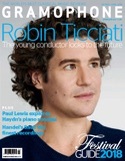Texte paru dans: / Appeared in: |
|
|
Outil de traduction (Très approximatif) |
|
|
Reviewer: Julie Anne Sadie What most strikes one about Marais’s Sémélé is the professional conception of this masterpiece of tragédie lyrique. Marais and his librettist Houdar de La Motte successfully contrived to keep the listener on the edge of his seat from beginning to end, first by maintaining a high level of dramatic tension brought to life with vivid musical contrasts, here brilliantly realised and paced by Hervé Niquet and the disciplined chorus and orchestra of Le Concert Spirituel; and second by plenty of character development, reflected in strong performances by Mercer as the naive, well-intentioned Semele, Dahlin as Adraste (the victim of the piece), Tauran shocking us with Dorine’s deceit and Thébault with Juno’s evil cunning. The production team ensured that the results were tightly edited into this twodisc set, first issued in 2008. Many artistic decisions separate us from Marais’s original 1709 realisation. Marais fortunately supervised the publication of a short score but the performance parts are lost. This is illustrated by a quick comparison with two admired recordings of Sémélé’s instrumental music: those by Montreal Baroque (ATMA Baroque, 2/07) and Les Ombres (Mirare, 5/15). Niquet and his team rely on the expertise of scholars at the Centre de Musique Baroque de Versailles, who have recreated Marais’s orchestration with great sensitivity. The familiar theme of conflict of royal duty over personal choice and the ensuing, ultimately destructive power struggle between gods and humans was a path already well trod in opera. Marais nevertheless ensured plenty of modern touches. Shapely recitatives lead seamlessly into enchanting airs, duos and dances. The dances include fashionable musettes evoking the sound of a hurdy-gurdy, a folk instrument coming into vogue among aristocratic amateurs, and a monumental chaconne, strategically positioned in Act 2 to crown Semele’s seduction by Jupiter. Superbly crafted choruses are a legacy of Marais’s boyhood training as chorister alongside Lalande. The known orchestral effects, too, were modern: the innovative use of solo trumpet in the prologue (disc 1, tracks 5 and 8) and the ethereal effect of two flutes in their upper range, accompanied by four violins (tracks 9 and 23). Musical evocations of subterranean rumbling (disc 2, track 6), an earthquake (track 31) and ultimate conflagration in the opera’s final scene are summoned up by the lavish continuo forces, which often provide suitably forceful accompaniments to vocal numbers. And yet, in spite of lavishing all the resources of the Académie Royale de Musique, Sémélé somehow failed to please. Marais and his collaborators had clearly neither factored the implications of the recent failure of other productions nor anticipated the terrible winter and famine raging at the time. The failure signalled the end of Marais’s 40-year career at the Opéra, first as a continuo player, then as a trusted batteur de mesure (conductor) and finally respected house composer. This reissue should serve to prompt another much deserved revival. |
|




